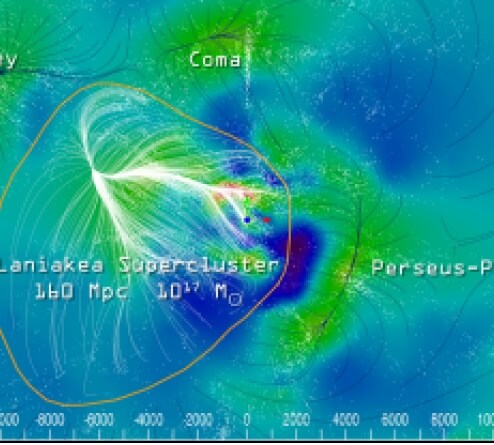A team of astronomers and astrophysicists that includes Prof. Yehuda Hoffman from the Rakah Institute of Physics at the Hebrew University recently engaged in studying the history of the local supercluster of galaxies (including ours). In an article published in NATURE last September, the supercluster mapped by the team is described and named "Laniakea" (meaning in the native language of Hawaii: "huge paradise").

A team of astronomers and astrophysicists that includes Prof. Yehuda Hoffman from the Rakah Institute of Physics at the Hebrew University recently engaged in studying the history of the local supercluster of galaxies (including ours). In an article published in NATURE last September, the supercluster mapped by the team is described and named "Laniakea" (meaning in the native language of Hawaii: "huge paradise").
A special video produced by the NATURE people about the research broke the magazine's record views this week and stands at about 2.6 million!
Galaxies are not randomly distributed throughout the universe, but accumulate in galaxy clusters. The local group we are in is a small cluster of two galaxies, the Milky Way and Andromeda. Galaxy clusters contain up to thousands of galaxies.
The galaxy clusters themselves accumulate and form "superclusters" (Wikipedia). The distribution of galaxies in space simulates a kind of network of webs - which looks similar to a network of spider webs and the networks of neurons in the brain - which leaves huge spaces devoid of galaxies and converges to the large clusters of galaxies. Defining the size and scope of "superclusters" remains open and challenging.
In their research, the team proposed a new way to define and measure these massive structures by examining their effect on the speed of galaxies. A galaxy between two such structures will be caught in a gravitational battle between the superclusters surrounding it, which will determine its speed and direction of movement. With the help of mapping the velocities of galaxies in the universe near us, the team was able to define the region in space over which the gravity of each supercluster "dominates".
The team's work, which was based on a combination of new observations and the new calculation method, led to the identification and mapping of the "Laniakea" as the local supercluster on whose edge we reside. The diameter of Laniakea is about 500 million light-years and its mass is 10 times the mass of the Sun to the 17th power.
The team included Prof. Brent Tully from the University of Hawaii (USA), Prof. Helene Courtois and Dr. Daniel Pomared from France.
More of the topic in Hayadan:

5 תגובות
If the film is so important, maybe you will donate it in Hebrew, not all Israeli surfers speak English in the professional language! Thanks!
I didn't understand what it had to do with IKEA
that you will light on "in addition you might like"
How is it possible that there is no mention of the Orion launch here??
http://www.ynet.co.il/articles/0,7340,L-4599646,00.html
The mass is not 1017 times, but 10 times to the 17th power